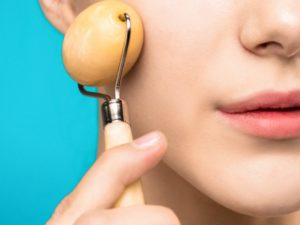Lactic Acid vs Glycolic Acid – Which Amazing Ingredient is Better for Your Skin
Two of the most popular AHAs go head to head today in this review of skincare. Lactic acid vs glycolic acid; which one is better for your skin?

Learn how these two exfoliating ingredients differ and which one you should pick. Spoiler alert, it depends.
Chemical Exfoliates vs Physical Exfoliates
Exfolation is a vital part of a simple skincare routine.
We know that physical exfoliants rely on, well, physical means to get rid of dead skin cells. This includes things like sugar scrubs or even tools like sponges or a loofa. These can at times be too harsh at times, especially on the face, causing microabrasions.
Chemical exfoliants rely on chemicals, usually acid, that strip the skin of dead skin cells. There are many different types, including AHA (alpha hydroxy acid) and BHA (beta hydroxy acid).
What is AHA and why choose it instead of BHA?
This one depends on your needs. AHA is usually derived from plant sources or cane sugar. They help to stimulate collagen, even skin tone, and increase cell turnover. BH is an oil-soluble acid that goes deep into pores. It is antibacterial and works great against acne while reducing dead skin cells on the surface.
Choose AHA if you want to target dead skin cells, reduce hyperpigmentation, reduce fine lines and wrinkles, restore plumpness, and increase moisture.
Choose BHA if you experience acne-prone skin, whiteheads, blackheads, or rosacea. It can also help reduce the appearance of pores and treat milia and ingrown hairs.
What is Lactic Acid
Lactic acid is an extremely common AHA as it is the most gentle. It is naturally derived from milk products but the ones used in skincare come from a laboratory or synthetic source.
Lactic acid works by dissolving the bonds between skin cells in the exfoliation process.
Lactic Acid Benefits
There are many benefits to using lactic acid. Because it is so gentle, it is safe for sensitive skin types.
Lactic acid can increase cell turnover, renewing cells and providing a bright complexion with smooth, even skin. Lactic acid has big molecules, meaning it will not penetrate deeply, reducing the risk of irritation.
It increases the natural moisturizing factors of the skin which improves collagen production.
What is Glycolic Acid
Glycolic acid is an AHA that increases cell turnover by dissolving the bonds holding cells together. It is usually derived from sugar cane or other plant sources.
It is a stronger, versatile AHA as it tends to penetrate deeper into the skin.
Glycolic Acid Benefits
Glycolic acid can increase collagen production greatly with its deep penetration. This can help smooth out fine lines and wrinkles and improve skin tone and texture.
It can also reduce hyperpigmentation, brighten the skin, and plump the skin overall. Not only that but the depth it absorbs into the skin does allow it to be good at resting acne like blackheads, whiteheads, and overall breakouts.
Glycolic acid, due to its smaller molecules, go deep to increase the production of hyaluronic acid and elastin.
Lactic Acid vs Glycolic Acid
They both work in the same way but here are the key differences between lactic acid and glycolic acid.
Lactic acid has bigger particles, meaning it does not penetrate as deep as glycolic. This can be good for sensitive skin. It also has the added benefit of improving the skin’s natural moisture level.
Glycolic acid has the smallest of all the AHA molecules, allowing it to penetrate deeper into the skin. This makes it effective at treating deep skin issues like dark spots. It reduces acne and boosts collagen.
However, the way they improve collagen differs.
Lactic acid increases moisturizing factors in the skin, which leads to a healthy skin barrier and an increased production of collagen.
Glycolic acid penetrates deep into the skin to stimulate fibroblasts which in turn increase collagen.
Both work similarly, breaking down the glue that binds cells to increase cell turnover. You must use sunscreen after the treatments as well as it can make your skin more sensitive to the sun.
Use glycolic acid if you are more comfortable using stronger products, have acne-prone skin, or want an intense, direct increase in collagen.
Use lactic acid if you have sensitive skin, or if you are new to exfoliating ingredients and want the benefits without the risk of damaging your skin barrier.
Quick Tips for Using AHA
Here are some tips and tricks you need to know before using any AHA product!
- Sunscreen, sunscreen, sunscreen -no seriously, if you don’t use sunscreen, you might end up damaging the skin and causing more problems. It is vital to apply 50+ SPF sunscreen when exfoliating the next day (but try to apply SPF daily honestly).
- Use the skin cycling method – The skin cycling method, of which a breakdown can be found here, can ensure your skin has time to benefit from the ingredients and recover.
- Start at a low concentration – start at a low concentration, then work your way up as your skin gets used to chemical exfoliators.
- Do not mix them – unless specifically formulated in one product, do not layer many different exfoliation products together. Vitamin C and exfoliators should not be used together, avoid retinol and exfoliation ingredients, and do not mix exfoliating acids. Check out this list of skincare ingredients you do not want to mix.
The Takeaway
Exfoliating ingredients work by increasing cell turnover and removing dead skin cells. Chemical exfoliates like AHA or BHA, are preferable over physical exfoliates.
Between those AHA targets skin issues while BHA targets acne, though as stated later, some AHA can be great at dealing with acne as well. When comparing lactic acid vs glycolic acid, they are very similar.
Lactic acid is an AHA that is gentle and has the added benefit of improving the moisture levels in the skin. Glycolic acid is the smallest of the AHA, meaning it penetrates deeper, making it a great option to boost collagen, reduce acne, and increase cell turnover.
Both brighten, and even skin tone, reduce the appearance of fine lines and wrinkles and improve skin overall.
If you have more sensitive skin or are just starting with exfoliation, you might want to choose lactic acid. If you want something stronger, or want to help control acne as well, glycolic acid is the way to go. Both provide amazing benefits, though they should not be used at the same time unless formulated to do so.
Choose one based on your skin needs and start slow and low, before moving on to higher concentrations.
Remember to use sunscreen to protect the skin as AHA can increase sensitivity to the sun. Arm yourself with the knowledge needed to support the skin and watch how you glow. Skincare is a journey that’s about progress, not perfection!




